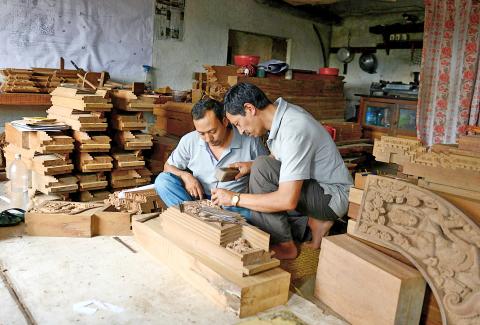In a dusty studio, Indra Kaji Shilpakar painstakingly carves intricate patterns into a wooden panel, one of a small group of highly skilled craftsmen Nepal is relying on to rebuild its cultural heritage after April’s major earthquake.
However, Shilpakar, a master craftsman who learned at the hands of his father and uncle as a young boy, is one of a dying breed.
The wood-carvers, stone-sculptors and metal-workers who created the spectacular temples and palaces of the Kathmandu Valley were once feted as far away as China and paid handsomely from the royal purse.

Photo: AFP
However, over the decades their social status has fallen along with the money they earn from their craft, and many young people are now rejecting the family trade to seek better paid work.
That has left the country short of skills crucial for rebuilding the centuries-old monuments of the Kathmandu Valley lost in the April 25 quake.
It is a problem made worse by the fact that these crafts have historically been the exclusive and jealously guarded preserve of a few families belonging to the Newar ethnic group indigenous to the valley.
Shilpakar, a slight, softly spoken man of 52, says all his male relatives as far back as anyone can remember have worked with wood, producing the intricately carved panels that grace Nepal’s temples and traditional homes.
“But many in the new generation want different jobs, office jobs,” he said in his studio in the historic city of Bhaktapur, where he is working on the restoration of a 17th-century three-tiered wooden pagoda temple.
“Even in my own family, there are people who have not continued with the work that requires a high level of skill, because it doesn’t pay,” said Shilpakar, whose uncle’s family has moved to the more lucrative furniture business.
“There isn’t much respect in Nepal — we are considered as workers, not artists,” he said.
That is not the view of the UN cultural agency UNESCO, which describes the stone, timber and bronze craftsmanship of the Newars as among the most highly developed in the world.
Many of the palaces and temples they created date back to the 12th to 18th centuries when Kathmandu Valley — a World Heritage site — was divided into the three kingdoms of Kathmandu, Patan and Bhaktapur.
Eager to lure back tourists, the government reopened the former Durbar (Royal) Squares of all three cities in June, despite warnings from UNESCO that this could cause further damage to the monuments.
They are home to some of the thousands of monuments damaged in the magnitude 7.8 quake, which killed nearly 9,000 people and destroyed about half a million homes.
The mammoth task of rebuilding has been delayed by the monsoon rains and by a political crisis that has held up a US$4.1 billion reconstruction fund.
When it does rebuild, UNESCO heritage expert Kai Weise believes a shortage of skilled craftsmen will be one of the key impediments.
“We are trying to get the government to acknowledge the importance of artisans and set up some kind of system,” he said.
“We need to find the master craftspersons and get them to train new artisans.”
The Kathmandu Valley Preservation Trust, a charity set up in 1991, also wants Nepal to set up a formal training system to preserve its unique skills.
“Generation to generation is not practical,” Nepal country director Rohit Ranjitkar said.
“If someone is interested in learning, they should be given the opportunity. There should be a professional school for this kind of work,” he said.
Conservationists are optimistic that at least some of the monuments can be restored, as happened after the last major quake that hit the valley in 1934.
They are not just tourist attractions — despite the rapid urbanization of Kathmandu, the three Durbar Squares remain at the heart of local cultural and spiritual life.
However, it is not difficult to see why young Nepalis are turning away from their family traditions. While the monarchs who funded this flourishing of art and architecture are celebrated with statues, the artists themselves have received little recognition in Nepal, whose last king left the throne in 2008.
Nonetheless Indra Kaji Shilpakar is determined to do all he can to help the country rebuild its architectural treasures.
“You feel pride when you look at a temple you have worked on. There’s a satisfaction in doing something for your country,” he said.
However, he admits he can earn more than twice as much carving crude wooden Buddha heads for shops to sell to tourists, and wants his sons to choose a different life.
Weise believes this lack of recognition must be addressed if Nepal is to rebuild.
“We are talking about millions of dollars, but without artisans we can’t rebuild anything,” he said.

To many, Tatu City on the outskirts of Nairobi looks like a success. The first city entirely built by a private company to be operational in east Africa, with about 25,000 people living and working there, it accounts for about two-thirds of all foreign investment in Kenya. Its low-tax status has attracted more than 100 businesses including Heineken, coffee brand Dormans, and the biggest call-center and cold-chain transport firms in the region. However, to some local politicians, Tatu City has looked more like a target for extortion. A parade of governors have demanded land worth millions of dollars in exchange

An Indonesian animated movie is smashing regional box office records and could be set for wider success as it prepares to open beyond the Southeast Asian archipelago’s silver screens. Jumbo — a film based on the adventures of main character, Don, a large orphaned Indonesian boy facing bullying at school — last month became the highest-grossing Southeast Asian animated film, raking in more than US$8 million. Released at the end of March to coincide with the Eid holidays after the Islamic fasting month of Ramadan, the movie has hit 8 million ticket sales, the third-highest in Indonesian cinema history, Film

Taiwan Semiconductor Manufacturing Co’s (TSMC, 台積電) revenue jumped 48 percent last month, underscoring how electronics firms scrambled to acquire essential components before global tariffs took effect. The main chipmaker for Apple Inc and Nvidia Corp reported monthly sales of NT$349.6 billion (US$11.6 billion). That compares with the average analysts’ estimate for a 38 percent rise in second-quarter revenue. US President Donald Trump’s trade war is prompting economists to retool GDP forecasts worldwide, casting doubt over the outlook for everything from iPhone demand to computing and datacenter construction. However, TSMC — a barometer for global tech spending given its central role in the

Alchip Technologies Ltd (世芯), an application-specific integrated circuit (ASIC) designer specializing in server chips, expects revenue to decline this year due to sagging demand for 5-nanometer artificial intelligence (AI) chips from a North America-based major customer, a company executive said yesterday. That would be the first contraction in revenue for Alchip as it has been enjoying strong revenue growth over the past few years, benefiting from cloud-service providers’ moves to reduce dependence on Nvidia Corp’s expensive AI chips by building their own AI accelerator by outsourcing chip design. The 5-nanometer chip was supposed to be a new growth engine as the lifecycle